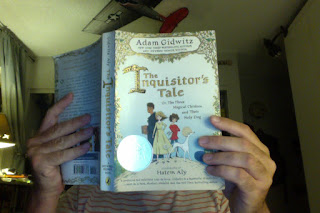Lucas Blogs About The Inquisitor's Tale
 |
| Illuminated throughout! |
Ugh! Is this gonna be a whole thing, Hypothetical Reader?
Aren't you in your thirties? Isn't this a legit children's book? Like for children too young to read YA?
Well, the back cover does say "Ages 10 up" so I think I'm allowed to read it.
Sorry, it's just, you know, with all these adults reading/watching/playing media marketed to children aren't we just dumbing down our culture and -
You can just shove that concern-trolling nonsense up your ass. This blog is called "Lucas Blogs About Books." If I reads, it ledes.
That's definitely not an expression, but okay. So, what's this book's deal?
The Inquisitor's Tale Or, The Three Magical Children and Their Holy Dog written by Adam Gidwitz and illuminated by Hatem Aly is the story of, well, three magical children and their holy dog. Gidwitz took inspiration from stories about medieval saints in creating the story of William, a young monk and the bastard son of a Christian knight and a Moorish woman who suddenly finds himself in possession of Herculean strength, Jeanne, a peasant girl who has fits which grant her visions of the future, Jacob, a Jewish boy who discovers healing powers when his town is set on fire, and Gwenforte, a greyhound who is venerated by the people of Jeanne's village before coming back from the dead. So you know, normal stuff. These three kids and their dog find themselves in conflict with King Louis IX (the one who's a saint) and his plans to burn every Talmud in France (real event).
So what makes this different from your bog standard middle grade historical novel?
Gidwitz uses a Canterbury Tales-like framing device where the story is related by a disparate group of travelers gathered at an inn, at the behest of the narrator who (SPOILER ALERT) is the titular Inquisitor, and is intensely interested in finding out just how it was that the king of France could be at war with three children and a dog. There are some places where this structure doesn't quite work, mostly when a medieval person explains something that any medieval person would be likely to know for the benefit of the kids reading the book.
Wait! Wait! Wait! You're complaining that a book aimed at children is too educational?
No, just that to an adult reader the more pedagogical elements of the story can break the illusion that this is a genuine medieval text. This is also the case when characters express some decidedly non-medieval ideas about religious tolerance.
But would kids be likely to be turned off by that?
Probably not. And the novel is convincingly medieval in other ways, from Aly's stylized marginalia (the book really is beautiful) to the occasional bursts of cartoonish violence and scatalogical humor. Oh, and the fact that the novel is largely concerned with religion and the nature of God.
So, like, it's overtly religious?
Yeah, one of the characters is even revealed to be (SPOILER ALERT) an angel, but I would hardly call it religious propaganda. If anything, the novel is more concerned about teaching kids not to make judgments about people based on factors like race, religion, gender, and socio-economic status. You know, "content of their character" kind of stuff.
Cool. So earlier, when you said that some of the characters express "non-medieval ideas?"
Hmm, that may be more of a reflection of my own ideas of how medieval people thought. In any case, Gidwitz does an excellent job of making his cast of characters appealing. The three children in particular, come across as realistic (if maybe too smart for their own good) ten-year-olds. And even Louis IX is shown to be more than just an out-and-out villain (though his mother, Blanche of Castile, is given a somewhat less nuanced portrayal).
Okay, so it sounds like you'd recommend it for kids, but what about adults?
Yeah. If you like fun stories with cool illustrations. Just bear in mind that you're not the target audience. Contrariwise, if you have no desire to see a picture of a farting dragon. then I guess you might not be interested in reading this.
That's a pretty specific thing to not want to see.
The Inquisitor's Tale or, The Three Magical Children and their Holy Dog by Adam Gidwitz, illuminated by Hatem Aly, Puffin Books Trade Paperback edition, 2018, 363 pages, pairs well with a flagon of small beer, a crust of bread, and a hunk of cheese
Links:
Adam Gidwitz's website, if you're into that kinda thing.
The Wikipedia entry for Saint Guinefort, the inspiration for this novel's holy dog.
A summary of the events leading to the burning of the Talmud in Paris in 1242 from Haaretz.
This review made me want to read the book, and now I have! I also recommend it!
ReplyDelete